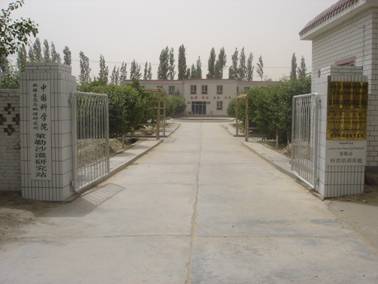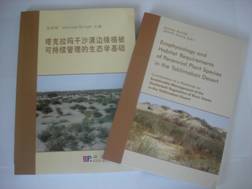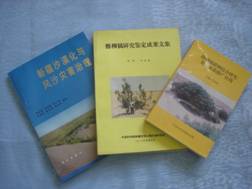Cele National Field Research Station for Desert Steppe Ecosystems
Located at 80°43'45"E and 37°00'57"N in Cele county on the southern fringe of the Taklimakan Desert, the Station was established as a part of the XIEG in 1983. It stands at an altitude of 1,318.6 m, covers an area of 100 hm2 and is 100 km from Hotan city and 1,400 km from Urumqi.
The Station is located in the transition zone between desert and oasis, which provides an optimal location for studying the fragile ecosystems. The research conducted at the Station contributes to sustainable management of the desert and oasis ecosystems and helps to stabilize the process of desertification. The vegetation in this area is dominated by the herbaceous legume Alhagi sparsifolia (Fabaceae), the salt cedar Tamarix ramosissima (Tamaricaceae), the poplar tree Populus euphratica (Salicaceae) and the herbaceous perennial Karelinia caspica (Asteraceae).
The Station is located to the north of the Kunlun Mountains and at the southern fringe of the Taklimakan Desert. This is one of the three extreme arid zones in the world—an extremely arid land in a warm temperate zone. Extreme drought in the region puts local ecosystems amongst the most fragile ecosystems in the world. The dominant landscape of the area is desert. The mean annual temperature is 11.9°C and the mean annual precipitation is 33 mm.
The Station is located in the leeward zone of the two dominant wind directions of the Tarim Basin, which results in a wind erosion zone with 1,400 km length. The blown sand is active and sand storms often occur there, seriously restricting the development of the economy and society of the area. The southern fringe of the Tarim Basin is one of the areas most affected by wind-blown sand in China.

Research Fields
(1) Ecological processes of desert ecosystems and their dynamic mechanisms
(2) Ecological processes of oasis ecosystems and their stability mechanisms
(3) Integration and demonstration of technology to control sand disasters

Lab measurement
Significant Projects
Thirteen projects are currently being implemented at the Station with a total budget of around 144 million yuan. The main projects are:
(1) Development and demonstration of key techniques for ecological stability through the use of economic shelter-belts in the periphery of the oasis at the southwest rim of the Tarim Basin (supported by the National Science & Technology Program, 4.50 million yuan, 2009-2013)
(2) Hydrological, pedological, climatic and botanical processes in the development of oases and their interactive mechanisms (supported by the National Basic Research Program of China (973), 2.70 million yuan, 2009-2013)
(3) Hydrological, pedological, climatic and botanical processes in desertification and their interactive mechanisms (supported by the National Basic Research Program of China (973), 1.00 million yuan, 2009-2013)
(4) Ecological study of the root systems of Alhagi sparsifolia seedling (supported by the National Natural Science Foundation of China (NSFC), 0.30 million yuan, 2007-2009)
(5) Ecological study of the root systems of Alhagi sparsifolia under different underground water conditions (supported bytheNational Natural Science Foundation of China (NSFC), 0.35 million yuan, 2009-2011)
Main Accomplishments
(1) Adaptability to adversity of main perennial plants
Systematic research into the adaptability to adversity of desert plants which grow in the south of Taklimakan Desert (for example: Alhagi sparsifolia (Fabaceae), Calligonum caput-medusae (Polygonaceae), Populus euphratica (Salicaceae) and Tamarix ramosissima (Tamaricaceae)), has yielded some new ideas about these desert plants, which have helped to enrich and develop knowledge of ecophysiology and vegetation ecology. At the same time, these works have provided some important theoretical basis for plant restoration in the south of the Taklimakan and other similar environments.
The results show that the primary perennial plants do not experience obvious water stress during their growth season. Analysis of the measurements, including physiological parameters (water potential, photosynthesis rate, transpiration rate and water use efficiency), biochemical index and growth index of these plants, showed that these desert plants had relatively good water supply status during several continuous growth periods. Despite the extreme drought condition, the transpiration rate of plants was not obviously limited by water deficiency. Normal flood irrigation didn’t have a marked effect on the plants’ water status. The plant roots had connected with the groundwater. This revealed that a very important precondition for the normal survival and growth of plants in this region is to maintain the stable level of groundwater and prevent the roots from being destroyed.
Main publications
Li X Y, Zhang X M, Zeng F J, et al. 2002. Water relations on Alhagi sparsifolia in the southern fringe of Taklamakan Desert. Acta Botanica Sinica, 44(10): 1219–1224.
Zeng F J, Yan H L, Arndt S K. 2009. Leaf and whole tree adaptations to mild salinity in field grown Populus euphratica. Tree Physiology, 29(10): 1237–1246.
(2) Clarifying the water use characteristics and productivity of main perennial plants
The water consumption of desert plant communities is high (up to 183-528 kg/(m2·a)), which is similar to the water consumption of deciduous forest communities with 1,000 mm annual precipitation in the temperate zone. Among the investigated plant species, the water utilization of Alhagi sparsifolia (Fabaceae) and Populus euphratica (Salicaceae) was especially higher than the others. This result demonstrates the good water supply condition of these perennial plants from another aspect.
The potential productivity of perennial plants is high, almost the same as the quantitative levels of plant types in the humid zone. The effect of irrigation on the productivity of these perennial desert plants can be neglected. The correlative relationship that had been confirmed between the biomass and productivity of plants had provided the basis for the establishment of the endurable use intensity of desert plants.
Main publications
Zeng F J, Bleby T M, Landman P A, et al. 2006. Water and nutrient dynamics in surface roots and soils are not modified by short-term flooding of phreatophytic plants in a hyperarid desert. Plant and soil, 279(1–2): 129–139.
Gries D, Zeng F J, Foetzki A, et al. 2003. Growth and water relations of Tamarix ramosissima and Populus euphratica on Taklimakan Desert dunes in relation to depth to a permanent water table. Plant, Cell and Environment, 26(5): 725– 736.
Thomas F M, Foetzki A, Arndt S K, et al. 2006. Water use by perennial plants in the transition zone between river oasis and desert in NW China. Basic and Applied Ecology, 7(3): 253–267.
(3) Explanation for the occurrence, progress and transport mechanism of sand storms in the southern fringe of Tarim Basin
The wind speed (9.5 m/s) required to develop sand-blown in wetness condition is 1.27 times greater than the wind speed required to blow dry sand in drought condition. There is a great difference in the wind speed of sand-blown under different ground surface condition (Gobi and quicksand environment).
The project studied the characteristics of the composition and the grain distribution of the dust in the southern fringe of the Tarim basin. The diameter of aerosol particles in the Taklimakan desert is between 4.7-7.0 μm and 3.3-4.7 μm.
Main publications
Ishizuka M, Mikami M, Yamada Y, et al. 2009. Threshold friction velocities of saltation sand particles for different soil moisture condition in the Taklimakan Desert. Sola, 5: 184–187.
Mikami M, Yamada Y, Ishizuka M, et al. 2005. Measurement of saltation process over gobi and sand dunes in the Taklimakan Desert, China, with newly developed sand particle counter. Journal of Geophysical Research, doi: 10.1029/2004JD004688.


Publications
Contact
Address: Cele Desert Research Station of Chinese Academy of Sciences, Cele County 848300, Hotan, Xinjiang, China
Director: Prof. Zeng Fanjiang Tel: +86-991-7885391
E-mail: zengfj@ms.xjb.ac.cn
- Appendix
-



